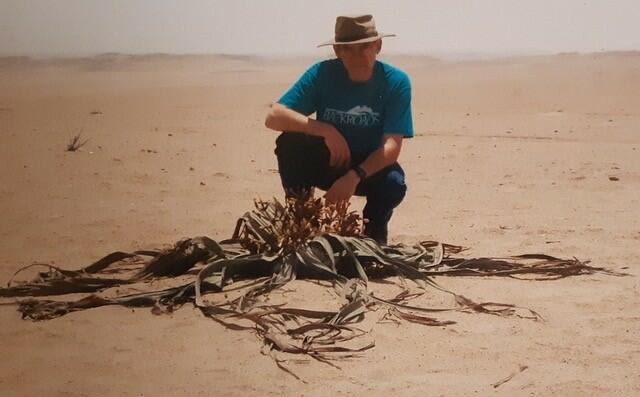April 11, 2023
Plants, pollinators and people: Students preserve a mutually beneficial relationship

Many plants depend on native bees, butterflies and other pollinators to thrive. In turn, people rely on plants and pollinators to produce up to one-third of all the food we eat.
But what are the impacts of urban environments, loss of habitat and climate change on this mutually beneficial relationship?
Students and faculty at the University of Calgary, in collaboration with members of the broader community, are helping to answer that question. And support from Giving Day donors can help ensure they keep searching for solutions.
The tools for their research and observations include the university’s herbarium and native Alberta bee collections, including digital reference biodiversity collections of photos available free online.
“These pollinators and plants play a critical role in increasing our food security and quality of life,” says Dr. Jana Vamosi, PhD, associate professor of ecology and evolutionary biology, and herbarium director, in the Department of Biological Sciences in the Faculty of Science.
In assessing the health and biodiversity of plants and pollinators, she says, “it’s really difficult to estimate how these components have changed over time until you compare them with historical records.”
Herbarium supports coursework and research
UCalgary’s herbarium consists of more than 105,000 preserved land plants from southern Alberta and throughout the world collected since the 1800s, including information on where the plants were found and what time of year they were in flower.
These records can be matched with weather conditions at that place and time period to estimate how environmental conditions have impacted floral resources available for pollinators over the past century.
Every year, the herbarium is used by UCalgary students in two plant biology courses, as well as by undergraduate and graduate students doing separate research.

Plants of Alberta: Pseudotsuga menziesii, or Douglas fir, found on Shaganappi Hill in Calgary — from the university’s herbarium.
A similar historical record is offered by UCalgary’s extensive collection of insects, which is also being digitized by students with help of the Taylor Family Digital Library. The collection includes bees native to Alberta (more than 330 species), along with other invertebrates.
“Having students and community members out taking photos and making observations will help us to better understand changes in biodiversity as we move into the future,” says Dr. Mindi Summers, PhD, an associate professor of ecology and evolutionary biology in the Department of Biological Sciences.
UCalgary was designated a Bee Campus about three years ago, recognizing the university’s efforts — including a Calgary Pollinator Count Community Science Project — in promoting pollinator, invertebrate and plant diversity on campus and in the broader community.
Students working with Summers did the first-ever citywide survey of insect biodiversity in Calgary in 2020 as part of a course-based research experience. Other student projects have helped The City of Calgary identify which plants are best for attracting pollinators to areas being restored, and have developed identification guides such as Bumble Bees of Calgary.
Student-led research, along with research by faculty members and elsewhere, has found some plant species flowering earlier now compared with 50 years ago and documented a decline in bumble bees and other insect populations.
Studying urban impacts on plants and pollinators in Calgary
Graduate student Justine Doll, for her Master of Science degree in ecology and evolutionary biology, is studying how urbanization affects the relationship between native and non-native plants and pollinators in Calgary.
UCalgary’s herbarium and insect collections will help her identify plants and pollinators, determine which plants are native versus non-native, and pinpoint when non-native plants started appearing in Alberta.
Through an online global repository and community called iNaturalist, which hosts the Calgary Pollinators page, Doll is encouraging citizens to make observations and take photos of pollinators. One of her recent posts to iNaturalist asking for help to identify insect specimens elicited 15 new Calgary Pollinator members and seven new curators who identified nearly 750 insect observations.
As part of her work in science communication and community outreach, Doll is planning walks this summer with community members, to collect information on plants and pollinators throughout Calgary.
“Currently, we have just over 6,000 pollinator observations. This summer, I’m hoping to increase engagement with the Calgary Pollinators Project and reach about 10,000 observations,” she says.

Isaac Rotstein next to a plant that only grows in the Namib desert of southern Africa.
Giving Day donations support a range of biodiversity activities
This January, the family of the late Isaac Rotstein – who graduated from UCalgary with a degree in zoology – donated more than 4,300 specimens Rotstein collected in 27 countries to the university’s herbarium.
Along with students, the herbarium is frequently used by environmental consultants, the Alberta Native Plant Council’s Calgary chapter, and botanical artists.
“Environmental consulting agencies regularly contact us to see if we have students trained and eager to be hired for positions as vegetarian ecologists,” Vamosi says.
With UCalgary's Giving Day happening in April, donors’ gifts will support biodiversity-focused student experiential learning opportunities in research and community outreach, including:
- Providing two undergrad students with a full summer’s research experience;
- Supporting student honour theses and independent study projects in fall and winter terms;
- Enabling students with UCalgary’s Office of Sustainability to develop programming and educational resources for this year’s Pollinator Week celebration (June 19-25); and
- Supporting Wagonstage Theatre – in a collaboration with the Department of Biological Sciences and the Faculty of Arts – in presenting a free play this summer about local environmental stewardship at city parks and community associations. Last year, the theatre group’s play about pollinators reached more than 2,100 children and families through 86 shows.
UCalgary Giving Day is April 27. Whether you support student awards, critical research or any one of UCalgary’s innovative funds, your gift will help change lives and shape the future. All eligible gifts made from April 1-27 will be matched, dollar for dollar, up to $2,500 per gift, while matching funds last. Make your gift today at ucalgary.ca/givingday.






